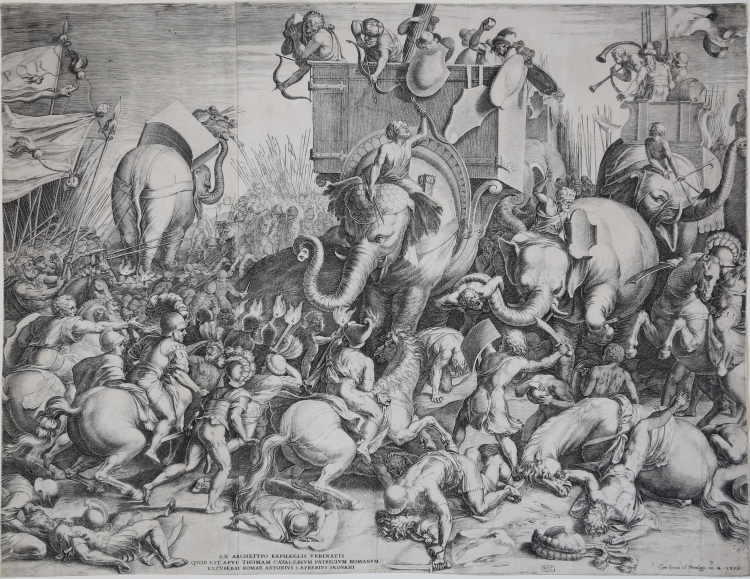




| Reference: | S47047 |
| Author | Cornelis CORT |
| Year: | 1567 |
| Measures: | 540 x 410 mm |



| Reference: | S47047 |
| Author | Cornelis CORT |
| Year: | 1567 |
| Measures: | 540 x 410 mm |
The battle between Scipio and Hannibal at Zama; a battle rages with footsoldiers, cavalry, pikemen and elephants; the elephants have fortified containers on their backs containing soldiers throwing rocks and archers etc.
Engraving, 1567, after Giulio Romano. Lettered below with reference to Tommaso de' Cavalieri, "EX ARCHETYPO RAPHAELIS URBINATIS / QUOD EST APUD THOMAM CAVALERIUM PATRICIUM ROMANUM / EXCUDEBAT ROMAE ANTONIVS LAFRERIVS SEOVANI". In lower right corner "Cum Gratia et Privilegio M.D.LXVII".
Example of the second state of four, with Antonio Lafreri's address and before Cornelis Cort's signature. The first state of the plate is a proof state
Magnificent impression, printed on two sheets of contemporary laid paper with a “anvil in a circle with a star” watermark, trimmed to the copperplate, traces of paper folds, otherwise in very good condition.
The subject depicts the Battle of Zama according to the description by Titus Livius in his Histories (XXX 33, 4-16) and is listed under the title Battaglia d'elefanti di Annibale et Scipione in Antonio Lafrery's inventory of 1572 (in Ehrle, 1908, no. 296).
The theme was engraved twice by Cort: the first print, known as The Battle of the Romans against Pyro (Le Blanc, II, 1856, no. 156), derives, as Bierens De Haan (1948, no. 196) observes, from the drawing, of problematic attribution, depicting the same subject preserved in the Louvre (Cabinet des Dessins, inv. 3717, fig. 99) attributed to Francesco Penni.
This version of Cornelis Cort's Battle of Zama seems to derive directly from Giulio's drawing belonging to the E. Gatteaux collection that was destroyed in 1871. The drawing, a photograph of which remains in the National Library of Paris, shows the outlines perforated for transfer. This sheet could be identified with the drawing that belonged to Tommaso Cavalieri, Michelangelo's great friend, as can be read in Cort's print (quod est apud Thomam Cavalerium patricium romanum). It is therefore likely that Cort, during his stay in Rome, which began in 1566 and lasted until 1578, reproduced this drawing directly on copper.
The subject, which contains numerous formal elements taken from the Battle of Ponte Milvio in the Vatican, would be created by Giulio in 1521-23 based on the drawing with Four Studies of Elephants (Oxford, Ashmolean Museum P II. 590) attributed to Giulio.
A fine example that belonged to the collection of Baron Henri de Triqueti (1802-1874), catalogued by Lugt under n. 1304.
Bibliografia
The New Hollstein: Dutch and Flemish etchings, engravings and woodcuts 1450-1700, n. 196.II/IV; Bierens de Haan, L'oeuvre gravé de Cornelis Cort, graveur hollandais 1533-1578 (197); S. Massari, Giulio Romano pinxit et delineavit, pp. 205-206, n. 192, II/IV.
Cornelis CORT (Hoorn, nr Alkmaar, 1533 - Roma, prima del 22 Aprile 1578)
|
North Netherlandish engraver and draughtsman, active in Flanders and Italy. His first documented works are a series of engravings issued by the Antwerp publisher Hieronymous Cock, beginning c. 1553. Cort may have been an apprentice within Cock’s establishment, as none of these prints was inscribed with his name until after the plates had passed out of Cock’s hands. A letter of 1567 to Titian from the Netherlandish writer and painter Domenicus Lampsonius (1532–99) describes Cock as Cort’s master. By 1560 Cort had developed a bold and strongly modelled sculptural style of engraving, influenced in part by the Italian Giorgio Ghisi, who worked for Cock between 1550 and 1555. Cort was particularly successful in reproducing the Italianate figure compositions of Frans Floris, after whom he engraved more than 50 prints, notably the Liberal Arts (seven prints; 1565) and the Labours of Hercules (ten prints; 1565). He also reproduced compositions by Maarten van Heemskerck, Andrea del Sarto, Rogier van der Weyden and others while working for Cock.
|
Cornelis CORT (Hoorn, nr Alkmaar, 1533 - Roma, prima del 22 Aprile 1578)
|
North Netherlandish engraver and draughtsman, active in Flanders and Italy. His first documented works are a series of engravings issued by the Antwerp publisher Hieronymous Cock, beginning c. 1553. Cort may have been an apprentice within Cock’s establishment, as none of these prints was inscribed with his name until after the plates had passed out of Cock’s hands. A letter of 1567 to Titian from the Netherlandish writer and painter Domenicus Lampsonius (1532–99) describes Cock as Cort’s master. By 1560 Cort had developed a bold and strongly modelled sculptural style of engraving, influenced in part by the Italian Giorgio Ghisi, who worked for Cock between 1550 and 1555. Cort was particularly successful in reproducing the Italianate figure compositions of Frans Floris, after whom he engraved more than 50 prints, notably the Liberal Arts (seven prints; 1565) and the Labours of Hercules (ten prints; 1565). He also reproduced compositions by Maarten van Heemskerck, Andrea del Sarto, Rogier van der Weyden and others while working for Cock.
|